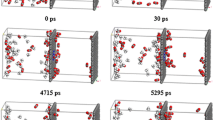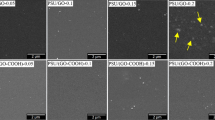Abstract
The utilization of hydrogen gas (H2) as an energy resource is a critical alternative to relieve the current greenhouse effect exacerbated by the excessive use of fossil fuels. The production of pure H2 is usually achieved by its separation from H2/CH4 and H2/CO2 mixtures; however, such process still represents a great challenge due to the inevitable contamination that occurs after the membrane sieving. Here, we investigate the ability of a 2-dimensional material, a nanoporous fluorinated graphene (F-GRA), to perform the separation of H2/CH4 and H2/CO2 using molecular dynamics simulations. We generated three representative nanopores with different morphologies in F-GRA sheets to separately explore their sieving performances for the H2 separation in the H2/CH4 and H2/CO2 mixtures. Our results revealed that the three F-GRA pores have an excellent performance for the H2/CH4 separation, displaying a high permeance for H2 (over 104 GPU) and a complete rejection for CH4; these results suggest an ideal permeability and selectivity for these 2D systems. Additionally, two F-GRA pores, namely, pore2 and pore3, also displayed high separation performance in the case of the H2/CO2 mixture, while the remaining pore, namely, pore1, exhibit poor performance due to the tight obstruction of the CO2 gas inside the nanopore. Combined, our findings exploit the utilization of the nanoporous F-GRA 2D material for the separation of H2/CH4 and H2/CO2 gas mixtures, which might open new possibilities for the future of gas sieving membrane preparation.





Similar content being viewed by others
Availability of data and material
All data will be available if required.
Code availability
Not applicable.
References
Gallucci F, Fernandez E, Corengia P, Annaland MV (2013) Recent advances on membranes and membrane reactors for hydrogen production. Chem Eng Sci 92:40–66. https://doi.org/10.1016/j.ces.2013.01.008
Liu H, Liu SQ (2021) Life cycle energy consumption and GHG emissions of hydrogen production from underground coal gasification in comparison with surface coal gasification. Int J Hydrogen Energ 46:9630–9643. https://doi.org/10.1016/j.ijhydene.2020.12.096
Sinha V, Govindarajan N, de Bruin B, Meijer EJ (2018) How solvent affects C-H activation and hydrogen production pathways in homogeneous Ru-catalyzed methanol dehydrogenation reactions. ACS Catal 8:6908–6913. https://doi.org/10.1021/acscatal.8b01177
Van Acht SCJ, Laycock CJ, Carr SJW, Maddy J, Guwy AJ, Lloyd G, Raymakers LFJM, Wright AD (2021) Optimization of VPSA-EHP/C process for high-pressure hydrogen recovery from coke oven gas using CO selective adsorbent. Int J Hydrogen Energ 46:709–725. https://doi.org/10.1016/j.ijhydene.2020.10.005
Li X, Singh RP, Dudeck KW, Berchtold KA, Benicewicz BC (2014) Influence of polybenzimidazole main chain structure on H2/CO2 separation at elevated temperatures. J Membrane Sci 461:59–68
Zhang G, Tang K, Zhang X, Xu L, Shen C, Meng Q (2021) Self-assembly of defect-free polymer-based zeolite imidazolate framework composite membranes with metal-phenolic networks for high efficient H2/CH4 separation. J Membrane Sci 617:118612
Altintas C, Avci G, Daglar H, Gulcay E, Erucar I, Keskin S (2018) Computer simulations of 4240 MOF membranes for H-2/CH4 separations: insights into structure-performance relations. J Mater Chem A 6:5836–5847. https://doi.org/10.1039/c8ta01547c
Fan HW, Mundstock A, Feldhoff A, Knebel A, Gu JH, Meng H, Caro J (2018) Covalent organic framework-covalent organic framework bilayer membranes for highly selective gas separation. J Am Chem Soc 140:10094–10098. https://doi.org/10.1021/jacs.8b05136
Yang FF, Wu MA, Wang YC, Ashtiani S, Jiang HQ (2019) A GO-induced assembly strategy to repair MOF nanosheet-based membrane for efficient H-2/CO2 separation. Acs Appl Mater Inter 11:990–997. https://doi.org/10.1021/acsami.8b19480
Li Z, Yang PP, Yan SC, Fang QR, Xue M, Qu SL (2019) A robust zeolitic imidazolate framework membrane with high H-2/CO2 separation performance under hydrothermal conditions. Acs Appl Mater Inter 11:15748–15755. https://doi.org/10.1021/acsami.9b01051
Hassani N, Ghorbani-Asl M, Radha B, Drndic M, Krasheninnikov AV, Neek-Amal M (2021) Gas permeability and selectivity of a porous WS2 monolayer. J Phys Chem C 125:25055–25066. https://doi.org/10.1021/acs.jpcc.1c06894
Ashirov T, Yazaydin AO, Coskun A (2022) Tuning the transport properties of gases in porous graphene membranes with controlled pore size and thickness. Adv Mater 34: 2106785. Artn 2106785. https://doi.org/10.1002/Adma.202106785
Villalobos LF, Vahdat MT, Dakhchoune M, Nadizadeh Z, Mensi M, Oveisi E, Campi D, Marzari N, Agrawal KV (2020) Large-scale synthesis of crystalline g-C3N4 nanosheets and high-temperature H2 sieving from assembled films. Sci Adv 6:eaay9851
Abraham MJ, Murtola T, Schulz R, Páll S, Smith JC, Hess B, Lindahl E (2015) GROMACS: high performance molecular simulations through multi-level parallelism from laptops to supercomputers. SoftwareX 1:19–25
Humphrey W, Dalke A, Schulten K (1996) VMD: visual molecular dynamics. J Mol Graph Model 14:33–38. https://doi.org/10.1016/0263-7855(96)00018-5
Hummer G, Rasaiah JC, Noworyta JP (2001) Water conduction through the hydrophobic channel of a carbon nanotube. Nature 414:188–190. https://doi.org/10.1038/35102535
Wang XX, Li BY, Bell DR, Li WF, Zhou RH (2017) Hydrogen and methane storage and release by MoS2 nanotubes for energy storage. J Mater Chem A 5:23020–23027. https://doi.org/10.1039/c7ta05995g
Taqieddin A, Heiranian M, Aluru NR (2020) Interfacial properties of water on hydrogenated and fluorinated graphene surfaces: parametrization of nonbonded interactions. J Phys Chem C 124:21467–21475. https://doi.org/10.1021/acs.jpcc.0c05951
Sun CZ, Zhu SH, Liu MC, Shen SH, Bai BF (2019) Selective molecular sieving through a large graphene nanopore with surface charges. J Phys Chem Lett 10:7188–7194. https://doi.org/10.1021/acs.jpclett.9b02715
Bussi G, Donadio D, Parrinello M (2007) Canonical sampling through velocity rescaling. J Chem Phys 126:014101. https://doi.org/10.1063/1.2408420
Darden T, York D, Pedersen L (1993) Particle mesh Ewald - An N.Log(N) method for ewald sums in large systems. J Chem Phys 98:10089–10092. https://doi.org/10.1063/1.464397
Essmann U, Perera L, Berkowitz ML, Darden T, Lee H, Pedersen LG (1995) A smooth particle mesh Ewald method. J Chem Phys 103:8577–8593. https://doi.org/10.1063/1.470117
Hess B, Bekker H, Berendsen HJC, Fraaije J (1997) LINCS: a linear constraint solver for molecular simulations. J Comput Chem 18:1463–1472. https://doi.org/10.1002/(sici)1096-987x(199709)18:12%3c1463::aid-jcc4%3e3.0.co;2-h
Hassani N, Ghorbani-Asl M, Radha B, Drndić M, Krasheninnikov AV, Neek-Amal M (2021) Gas permeability and selectivity of a porous WS2 monolayer. J Phys Chem C 125:25055–25066
Acknowledgements
We thank Shuming Zeng for helping with the manuscript.
Funding
Zonglin Gu acknowledges the support of the National Natural Science Foundation of China (No. 12104394), the Natural Science Foundation for Colleges and Universities in Jiangsu Province (No. 21KJB140024), and the Youth Hundred Talents Program of Yangzhou University. Lu Liu acknowledges the support of the Science and Technology Attack Projects of Henan Province (No. 222102310387).
Author information
Authors and Affiliations
Contributions
Zonglin Gu conceived the concept and designed the study. Zonglin Gu and Tian Wang carried out the theoretical calculations and analysis. Zonglin Gu, Jose Manuel Perez-Aguilar, and Lu Liu co-wrote the paper. All authors discussed the results and commented on the manuscript.
Corresponding authors
Ethics declarations
Competing interests
The authors declare no competing interests.
Additional information
Publisher's Note
Springer Nature remains neutral with regard to jurisdictional claims in published maps and institutional affiliations.
Supplementary Information
Below is the link to the electronic supplementary material.
Rights and permissions
Springer Nature or its licensor (e.g. a society or other partner) holds exclusive rights to this article under a publishing agreement with the author(s) or other rightsholder(s); author self-archiving of the accepted manuscript version of this article is solely governed by the terms of such publishing agreement and applicable law.
About this article
Cite this article
Wang, T., Liu, L., Perez-Aguilar, J.M. et al. Single-layered fluorinated graphene nanopores for H2/CH4 and H2/CO2 separation with high efficiency and selectivity. J Mol Model 28, 403 (2022). https://doi.org/10.1007/s00894-022-05400-8
Received:
Accepted:
Published:
DOI: https://doi.org/10.1007/s00894-022-05400-8




